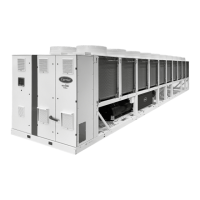10.2 - Level 2 maintenance
See Note above.
This level requires specic expertise in electrical, hydraulic and mechanical systems. it is possible that this expertise may be available
locally; there may be a maintenance service, industrial site or specialist subcontractor in the area.
In these cases, the following maintenance operations are recommended:
Carry out all level 1 operations, then:
Mechanical :
Check that the mounting bolts for the ventilation sub-assemblies,
fans, compressors, and electrical boxes are securely tightened.
Electrical :
At least once a year, tighten the electrical connections for the
power supply circuits (see tightening torques table)
Check and tighten all control connections, as required.
Check that the dierential circuit breakers are operating correctly
every 6 months (if present).
Remove the dust and clean the interior of the electrical boxes, as
necessary. Check the condition of the lters.
Check that the electrical protective devices are present and in
good condition.
Replace the fuses every 3 years or every 15000 hours (ageing).
Replace the electrical box cooling fans every 5 years.
Check the height of the anti-vibration mounts (located between
the feet of the oil separator and the support rails) after 5 years of
use, and each year thereafter. Once the total minimum height of
the mount is less than 25 mm, the mounts will need replacing.
Check that the electrical boxes air inlet and outlet are not
obstructed. If yes, clean them (sand, dust, leaves…).
Hydraulics:
■ When working on the hydraulic circuit, take care not to damage
the adjacent air heat exchanger,
■ Check the water connections,
■ Check the condition of the expansion tank (presence of
corrosion or loss of gas pressure) and replace it if required,
■ Drain the water circuit (see chapter "Water flow control
procedure"),
■ Clean the water lter (see chapter "Water ow rate control
procedure"),
■ Replace the packing around the pump body after 20,000 hours
of operation and the bearings after 20,000 hours,
■ Check the operation of the ow switch,
■ Check the condition of pipe thermal insulation,
■ Check the concentration of the anti-freeze protection solution
(ethylene glycol or propylene glycol),
■ Check the water flow via the heat exchanger pressure
dierence,
■ Check the condition of the heat-transfer uid or the water quality,
■ Check for corrosion of the steel pipe work.
■ Check the unit operating parameters, compare them with the
previous values and note any changes,
■ Keep an up-to-date service record specic to the refrigeration
unit in question.
■ Inside the electrical box, check that there is voltage on
the connection terminals for the evaporator heaters and
variable-speed drives (activate quick test mode to control
the heaters).
Refrigerant circuit :
■ The unit is subject to F-gas tight regulatory checks. Please refer
to the table in the introduction,
■ Check the unit operating parameters and compare them with
the previous values,
■ Check the operation of the high pressure switches. Replace
them if there is a fault,
■ Check the fouling of the lter drier. Replace it if necessary,
■ Keep an up-to-date service booklet specic to the refrigeration
unit in question.
IMPORTANT: Ensure all adequate safety measures are taken
for all these operations: Use appropriate PPE (personal
protective equipment), comply with all applicable industry
and local regulations, and use common sense.
10 - SYSTEM STANDARD MAINTENANCE
56

